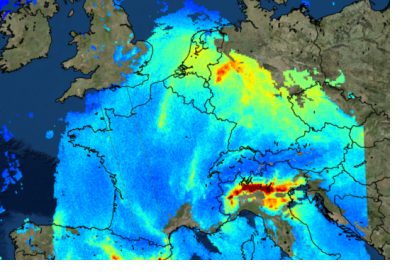On 11 July 2018, the first data on air quality by Copernicus Sentinel-5P was released. Presenting a great improvement in accuracy for monitoring air pollutants, these maps show the presence of trace gases such as ozone, nitrogen dioxide and carbon monoxide. Additional data products such as the Aerosol index can provide information on atmospheric volcanic ash for aviation safety and on high levels of UV radiation.
Sentinel-5 Precursor was created to reduce the data gap between Envisat and Sentinel-5, which is set to be launched ~2021. Sentinel-5P is part of the constellation of SENTINEL-4, -5 and -5 precursor (S4, S5, S5P), developed by the European Space Agency, to gather information on atmospheric variables to support European policies.
High expectations are set on Sentinel 5P, as it carries the Tropomi instrument - the most advanced multispectral imaging spectrometer to date. The instrument measures waves in the ultraviolet (UV), visible (VIS), near (NIR) and short-wavelength infrared (SWIR). Due to its very high resolution of up to 7 x 3.5 km, the Troposheric Monitoring Instrument (Tropomi) can detect air pollution over cities and ship lanes. Initial data illustrated hot spots of nitrogen dioxide pollution over Europe, Africa, the Middle East, and India. Sentinel’s swath width of 2600km allows it to map the whole planet every 24 hours.
Data Access
Copernicus Sentinel-5P data is available to all, free of charge on the Sentinel-5P Pre-Operations Data Hub. In addition, its orbit and heat maps as well as other data products can be visually monitored on the Tropomi Portal.
Developers
The tropomi instrument was built by a joint venture between the Netherlands Space Office, Royal Netherlands Meteorological Institute, Netherlands Institute for Space Research, Netherlands Organisation for Applied Scientific Research and Airbus Defence and Space Netherlands.

